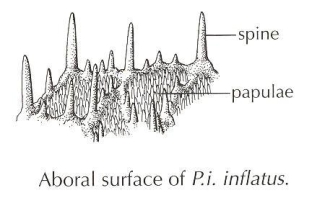Family Description:
Short armed and star shaped or almost pentagonal in form; the upper side is arched, the lower side flat. The aboral plates form a compact or open reticulum, but are obscured by a thick, opaque skin. Some have carinals linked to the marginals by an open reticulum with large nodal plates (as in Poraniopsis); only Poraniopsis has spines at each node. The marginals vary from prominent to small or absent; they are covered with skin and usually have no prominent spines. The oral intermediates run parallel to the inferomarginals. The adambulacrals have a few sheathed spines. Spaced or clustered papulae; no pedicellariae.
